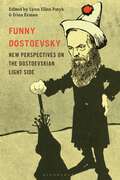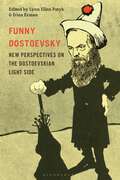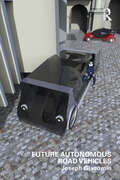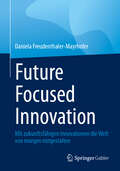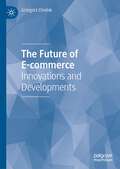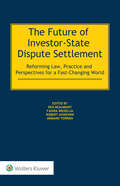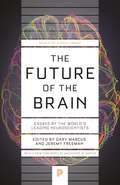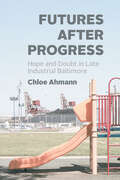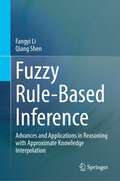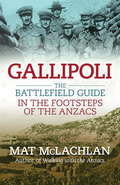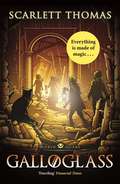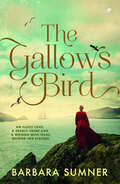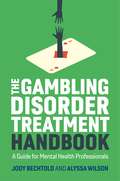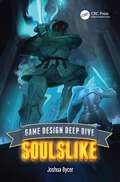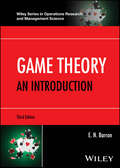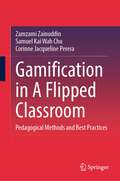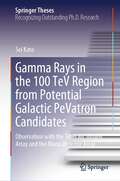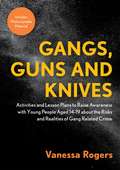- Table View
- List View
Funny Dostoevsky: New Perspectives on the Dostoevskian Light Side
by Lynn Ellen Patyk and Irina ErmanTapping into the emergence of scholarly comedy studies since the 2000s, this collection brings new perspectives to bear on the Dostoevskian light side. Funny Dostoevksy demonstrates how and why Dostoevsky is one of the most humorous 19th-century authors, even as he plumbs the depths of the human psyche and the darkest facets of European modernity. The authors go beyond the more traditional categories of humor, such as satire, parody, and the carnivalesque, to apply unique lenses to their readings of Dostoevsky. These include cinematic slapstick and the body in Crime and Punishment, the affective turn and hilarious (and deadly) impatience in Demons, and ontological jokes in Notes from Underground and The Idiot. The authors – (coincidentally?) all women, including some of the most established scholars in the field alongside up-and-comers – address gender and the marginalization of comedy, culminating in a chapter on Dostoevsky's "funny and furious" women, and explore the intersections of gender and humor in literary and culture studies. Funny Dostoevksy applies some of the latest findings on humor and laughter to his writing, while comparative chapters bring Dostoevsky's humor into conjunction with other popular works, such as Chaplin's Modern Times and Lin-Manuel Miranda's Hamilton. Written with a verve and wit that Dostoevsky would appreciate, this boldly original volume illuminates how humor and comedy in his works operate as vehicles of deconstruction, pleasure, play, and transcendence.
Funny Dostoevsky: New Perspectives on the Dostoevskian Light Side
Tapping into the emergence of scholarly comedy studies since the 2000s, this collection brings new perspectives to bear on the Dostoevskian light side. Funny Dostoevksy demonstrates how and why Dostoevsky is one of the most humorous 19th-century authors, even as he plumbs the depths of the human psyche and the darkest facets of European modernity. The authors go beyond the more traditional categories of humor, such as satire, parody, and the carnivalesque, to apply unique lenses to their readings of Dostoevsky. These include cinematic slapstick and the body in Crime and Punishment, the affective turn and hilarious (and deadly) impatience in Demons, and ontological jokes in Notes from Underground and The Idiot. The authors – (coincidentally?) all women, including some of the most established scholars in the field alongside up-and-comers – address gender and the marginalization of comedy, culminating in a chapter on Dostoevsky's "funny and furious" women, and explore the intersections of gender and humor in literary and culture studies. Funny Dostoevksy applies some of the latest findings on humor and laughter to his writing, while comparative chapters bring Dostoevsky's humor into conjunction with other popular works, such as Chaplin's Modern Times and Lin-Manuel Miranda's Hamilton. Written with a verve and wit that Dostoevsky would appreciate, this boldly original volume illuminates how humor and comedy in his works operate as vehicles of deconstruction, pleasure, play, and transcendence.
Future Autonomous Road Vehicles
by Joseph GiacominThis book provides a comprehensive overview of the past, present and future of autonomous road vehicles for professionals and students.Split into three parts, the first section of the book brings together the key historical developments in autonomous road vehicle design and the primary explorations of the design possibilities from science fiction. This historical analysis draws upon significant test vehicles from history and explores their roles as landmarks in the evolution of the field. In addition, it also reviews the history of science fiction and outlines the key speculations about autonomous road vehicles which emerged from that world. In the second section of the book, Joseph Giacomin introduces five of the most popular future-facing speculative approaches used by designers. In doing so, he identifies the major user-facing challenges which affect ideation, product design, service design and business modelling. In the final part, science fiction prototyping is identified as the speculative approach best suited to autonomous road vehicle application. Connecting theory with practice, Giacomin provides examples of sixteen science fiction prototypes, which cover a comprehensive range of physical, psychological, sociological and ethical design challenges.Written as an accessible guide for design practitioners and students, this book will be of use to those interested in the psychological, sociological and ethical factors involved in automotive design, human-centred design, industrial design and technology.
Future Autonomous Road Vehicles
by Joseph GiacominThis book provides a comprehensive overview of the past, present and future of autonomous road vehicles for professionals and students.Split into three parts, the first section of the book brings together the key historical developments in autonomous road vehicle design and the primary explorations of the design possibilities from science fiction. This historical analysis draws upon significant test vehicles from history and explores their roles as landmarks in the evolution of the field. In addition, it also reviews the history of science fiction and outlines the key speculations about autonomous road vehicles which emerged from that world. In the second section of the book, Joseph Giacomin introduces five of the most popular future-facing speculative approaches used by designers. In doing so, he identifies the major user-facing challenges which affect ideation, product design, service design and business modelling. In the final part, science fiction prototyping is identified as the speculative approach best suited to autonomous road vehicle application. Connecting theory with practice, Giacomin provides examples of sixteen science fiction prototypes, which cover a comprehensive range of physical, psychological, sociological and ethical design challenges.Written as an accessible guide for design practitioners and students, this book will be of use to those interested in the psychological, sociological and ethical factors involved in automotive design, human-centred design, industrial design and technology.
Future Focused Innovation: Mit zukunftsfähigen Innovationen die Welt von morgen mitgestalten
by Daniela Freudenthaler-Mayrhofer„Ist unser Unternehmen optimal für zukünftige Entwicklungen aufgestellt?“, „Gelingt es uns, die wesentlichen Transformationen im Umfeld zu erkennen und mitzuprägen?“, „Sind wir fähig, Innovationen für eine noch unbekannte Welt zu entwickeln?“ – diese und ähnliche Fragen beschäftigen Führungskräfte, da sie für die Zukunftsfähigkeit einer Organisation von hoher Relevanz sind.Der Blick in die Zukunft ist ungewiss, herausfordernd und für jedes Unternehmen höchst individuell. Umso offener, positiver und konstruktiver Menschen und Organisationen auf das Morgen blicken, desto größer unsere Handlungsspielräume. Jedes Unternehmen, das den Anspruch stellt, die Zukunft aktiv mitgestalten zu wollen, braucht einen weitblickenden Prozess, der nutzerorientierte Innovationsmodelle um die Entwicklung von Zukunftsbildern erweitert.Das vorliegende Buch bietet einen neuen, zukunftsorientierten Innovationsansatz, der das klassische nutzerorientierte Innovationsmodell fortentwickelt und um die Zukunftsperspektive erweitert. Die Autorin erläutert anschaulich, wie die Auseinandersetzung mit wünschenswerten Zukünften die Innovationsarbeit in Unternehmen wesentlich bereichern kann und stellt ein Modell vor, das bekannte Innovationsprozesse um das Explorieren von Trends, das Formulieren von Visionen und das proaktive Entwickeln von Strategien ergänzt.Ausgewählte Fallbeispiele von Unternehmen zeigen, wie individuell und vielschichtig die Gestaltung der Unternehmenszukunft in der Praxis aussehen kann. Sie dienen damit als Inspiration für den eigenen Umgang in der Innovationsarbeit. Mit Beiträgen von:Barbara BoucekThomas FrauscherMarkus KretschmerChristopher LindingerSandra MagerMartina MaraAndrea MassimianiElisabeth SpitzenbergerPatricia Wiendl-Stark
The Future of E-commerce: Innovations and Developments
by Grzegorz ChodakThe e-commerce industry is growing year by year, with the COVID-19 pandemic having greatly accelerated this process. In response to the massive growth, this book analyses future trends in e-commerce, focusing on its importance in some parts of the economy as well key innovations, which include future logistics solutions such as automated delivery robots. The most extensive part of the book is dedicated to exploring virtual reality in e-commerce, where the author presents research on the usage of VR goggles in online stores and discusses the potential advantages and threats. Also covering key topics such as the future of payment methods, AR as an e-commerce enhancement and the direction of its development, as well as AI methods (such as ChatGPT to generate content in an online shop), this book is a key resource for anyone studying e-business.
The Future of Investor-State Dispute Settlement: Reforming Law, Practice and Perspectives for a Fast-Changing World
by Ben Beaumont Fahira Brodlija Robert Ashdown Armand TerrienWhat makes investor-State dispute settlement (ISDS) as dynamic a field as it is – especially in comparison with international commercial arbitration – is its uncanny ability to engage directly with the most topical and pressing issues of the day, including human rights, regulation of the energy sector, and climate change and the environment more generally. This book provides a deep dive into the reality behind the causes and effects of the expressed concerns regarding ISDS and the extent to which they can and have been addressed by ongoing reform processes at national, regional, and international levels. Deeply informed insights from leading scholars and practitioners on the status quo and perspectives of ISDS shed clear light on such aspects as the following: reform instruments adopted at the UNCITRAL Working Group III; issues surrounding the legitimacy of ISDS; dispute prevention and amicable settlement mechanisms; the proposed multilateral investment court; implications of climate change and energy transition for investment policies and disputes; recent regional trends in policymaking and perspectives; the ICSID-UNCITRAL Code of Conduct; investment protection standards and dispute resolution mechanisms in recent international investment treaties; viability of the modernized Energy Charter Treaty; use of artificial intelligence; and participation of civil society organizations. As an in-depth analysis of the most recent developments in international investment law and dispute resolution, this book offers a realistic view of the reform processes, thus underlining the necessary legal and institutional measures that will translate into real-life effects in the future. With its help, policymakers and government officials will identify ongoing trends and anticipate risks that require intervention, while practitioners and the broader dispute resolution community will find valuable information about the evolving contours of investment protection treaties and ISDS. For academics and civil society organizations interested in the developments and implications of ISDS, the book provides factual, nuanced, and effective analysis of the relevant issues.
The Future of the Brain: Essays by the World's Leading Neuroscientists (Princeton Science Library #146)
by Gary Marcus and Jeremy FreemanThe world's top experts take readers to the very frontiers of brain scienceIncludes a chapter by 2014 Nobel laureates May-Britt Moser and Edvard MoserAn unprecedented look at the quest to unravel the mysteries of the human brain, The Future of the Brain takes readers to the absolute frontiers of science. Original essays by leading researchers such as Christof Koch, George Church, Olaf Sporns, and May-Britt and Edvard Moser describe the spectacular technological advances that will enable us to map the more than eighty-five billion neurons in the brain, as well as the challenges that lie ahead in understanding the anticipated deluge of data and the prospects for building working simulations of the human brain. A must-read for anyone trying to understand ambitious new research programs such as the Obama administration's BRAIN Initiative and the European Union's Human Brain Project, The Future of the Brain sheds light on the breathtaking implications of brain science for medicine, psychiatry, and even human consciousness itself.Contributors include: Misha Ahrens, Ned Block, Matteo Carandini, George Church, John Donoghue, Chris Eliasmith, Simon Fisher, Mike Hawrylycz, Sean Hill, Christof Koch, Leah Krubitzer, Michel Maharbiz, Kevin Mitchell, Edvard Moser, May-Britt Moser, David Poeppel, Krishna Shenoy, Olaf Sporns, Anthony Zador.
The Future of the Brain: Essays by the World's Leading Neuroscientists (Princeton Science Library #146)
by Gary Marcus Jeremy Freeman Mackenzie W. MathisThe world's top experts take readers to the very frontiers of brain scienceIncludes a chapter by 2014 Nobel laureates May-Britt Moser and Edvard MoserAn unprecedented look at the quest to unravel the mysteries of the human brain, The Future of the Brain takes readers to the absolute frontiers of science. Original essays by leading researchers such as Christof Koch, George Church, Olaf Sporns, and May-Britt and Edvard Moser describe the spectacular technological advances that will enable us to map the more than eighty-five billion neurons in the brain, as well as the challenges that lie ahead in understanding the anticipated deluge of data and the prospects for building working simulations of the human brain. A must-read for anyone trying to understand ambitious new research programs such as the Obama administration's BRAIN Initiative and the European Union's Human Brain Project, The Future of the Brain sheds light on the breathtaking implications of brain science for medicine, psychiatry, and even human consciousness itself.Contributors include: Misha Ahrens, Ned Block, Matteo Carandini, George Church, John Donoghue, Chris Eliasmith, Simon Fisher, Mike Hawrylycz, Sean Hill, Christof Koch, Leah Krubitzer, Michel Maharbiz, Kevin Mitchell, Edvard Moser, May-Britt Moser, David Poeppel, Krishna Shenoy, Olaf Sporns, Anthony Zador.
Futures after Progress: Hope and Doubt in Late Industrial Baltimore
by Chloe AhmannA powerful ethnographic study of South Baltimore, a place haunted by toxic pasts in its pursuit of better futures. Factory fires, chemical explosions, and aerial pollutants have inexorably shaped South Baltimore into one of the most polluted places in the country. In Futures after Progress, anthropologist Chloe Ahmann explores the rise and fall of industrial lifeways on this edge of the city and the uncertainties that linger in their wake. Writing from the community of Curtis Bay, where two hundred years of technocratic hubris have carried lethal costs, Ahmann also follows local efforts to realize a good future after industry and the rifts competing visions opened between neighbors. Examining tensions between White and Black residents, environmental activists and industrial enthusiasts, local elders and younger generations, Ahmann shows how this community has become a battleground for competing political futures whose stakes reverberate beyond its six square miles in a present after progress has lost steam. And yet—as one young resident explains—“that’s not how the story ends.” Rigorous and moving, Futures after Progress probes the deep roots of our ecological predicament, offering insight into what lies ahead for a country beset by dreams deferred and a planet on the precipice of change.
Fuzzy Rule-Based Inference: Advances and Applications in Reasoning with Approximate Knowledge Interpolation
by Fangyi Li Qiang ShenThis book covers a comprehensive approach to the development and application of a suite of novel algorithms for practical approximate knowledge-based inference. It includes an introduction to the fundamental concepts of fuzzy sets, fuzzy logic, and fuzzy inference. Collectively, this book provides a systematic tutorial and self-contained reference to recent advances in the field of fuzzy rule-based inference. Approximate reasoning systems facilitate inference by utilizing fuzzy if-then production rules for decision-making under circumstances where knowledge is imprecisely characterized. Compositional rule of inference (CRI) and fuzzy rule interpolation (FRI) are two typical techniques used to implement such systems. The question of when to apply these potentially powerful reasoning techniques via automated computation procedures is often addressed by checking whether certain rules can match given observations. Both techniques have been widely investigated to enhance the performance of approximate reasoning. Increasingly more attention has been paid to the development of systems where rule antecedent attributes are associated with measures of their relative significance or weights. However, they are mostly implemented in isolation within their respective areas, making it difficult to achieve accurate reasoning when both techniques are required simultaneously. This book first addresses the issue of assigning equal significance to all antecedent attributes in the rules when deriving the consequents. It presents a suite of weighted algorithms for both CRI and FRI fuzzy inference mechanisms. This includes an innovative reverse engineering process that can derive attribute weightings from given rules, increasing the automation level of the resulting systems. An integrated fuzzy reasoning approach is then developed from these two sets of weighted improvements, showcasing more effective and efficient techniques for approximate reasoning. Additionally, the book provides an overarching application to interpretable medical risk analysis, thanks to the semantics-rich fuzzy rules with attribute values represented in linguistic terms. Moreover, it illustrates successful solutions to benchmark problems in the relevant literature, demonstrating the practicality of the systematic approach to weighted approximate reasoning.
Gallipoli: The battlefield guide
by Mat McLachlanThe essential travel companion for anyone visiting Gallipoli.Each year, thousands of Australians visit Gallipoli to pay homage and see where their forebears fought, suffered and died. Anzac Cove, Quinn's Post, Lone Pine - the iconic places where our national legend was forged.In this essential and authoritative guide, practical information is combined with historical detail, alongside revealing and often heartrending quotes from the letters and diaries of the Anzacs themselves.- Detailed easy-to-follow plans for walking and driving tours across the main battlefields- Maps, photos and historical commentary to put the campaign in context- Everything you need to know where to go, where to stay and how to get there.Walk where the Anzacs walked, see where they fought and marvel at their courage.
Galloglass (Worldquake #3)
by Scarlett ThomasEVERYTHING IS MADE OF MAGIC . . . Effie Truelove and friends Lexy, Wolf, Maximilian and Raven must use their magical skills to defeat the Diberi, a corrupt organisation intent on destroying the worlds at Midwinter. But during a visit to the Otherworld, Effie is mistaken and imprisoned for being a galloglass – a dangerous, selfish islander. Can Effie and her friends reunite before total destruction is wreaked upon the universe?
The Gallows Bird
by Barbara SumnerA story of enduring love and friendship, and bold wild women who refuse the dictates of their times. London 1833: The cast-out child of an aristocratic mother, Hannah 'Birdie' Bird is a laundry maid with a hidden past and a suspicion that the wealthy family she serves is hers. Longing for beauty and liberation, Birdie risks everything to change her circumstances. She falls into love and crime, committing an audacious heist. When she is betrayed, she finds herself swept into a wave of female convicts, transported to the ends of her known world. The journey to the early Australian settlement drives the women to deepest despair. Birdie finds wonder in even this darkest hour, and forms deep bonds with her fellow prisoners. But greater than even the trials onboard is the fear of what awaits them in Sydney Cove. What chance does Birdie have of beating the odds? Can she fight her way to freedom? Drawn from the rarely celebrated true stories of female convicts, this striking debut vividly evokes a far-off time.
The Gambling Disorder Treatment Handbook: A Guide for Mental Health Professionals
by Jody Bechtold Alyssa WilsonThis handbook provides mental health professionals with a thorough understanding of the biopsychosocial nature of disordered gambling and shares current evidence-based theories, interventions and strategies to use in clinical practice. It provides guidance for working with individuals of any age and covers different gambling modes, activities and subtypes, including new forms of gambling through online and virtual platforms. Drawing on the authors' substantial experience working with and researching gambling addiction, it considers how treatment can be specialized for particular client groups, including trauma survivors, military, older adults, adolescents and diverse communities. It provides detailed diagnostic and screening resources and includes important information on the financial and legal aspects.This is essential reading for any therapist treating clients with gambling disorder.
The Gambling Disorder Treatment Handbook: A Guide for Mental Health Professionals
by Jody Bechtold Alyssa WilsonThis handbook provides mental health professionals with a thorough understanding of the biopsychosocial nature of disordered gambling and shares current evidence-based theories, interventions and strategies to use in clinical practice. It provides guidance for working with individuals of any age and covers different gambling modes, activities and subtypes, including new forms of gambling through online and virtual platforms. Drawing on the authors' substantial experience working with and researching gambling addiction, it considers how treatment can be specialized for particular client groups, including trauma survivors, military, older adults, adolescents and diverse communities. It provides detailed diagnostic and screening resources and includes important information on the financial and legal aspects.This is essential reading for any therapist treating clients with gambling disorder.
Game Design Deep Dive: Soulslike
by Joshua BycerGame Design Critic Joshua Bycer is back with another entry in the Game Design Deep Series to focus on the youngest genre yet: soulslikes. Over a decade, From Software defined a new genre that has led to studios chasing after them hit after hit. In this book, Josh will cover the history of the genre and popular soulslike games of the 2010s and discuss what aspects of design make a game a soulslike. The first book looking at the history of the genre A breakdown of both action and RPG design for fans and designers of both A lesson on difficulty in games and why harder doesn’t mean better
Game Design Deep Dive: Soulslike
by Joshua BycerGame Design Critic Joshua Bycer is back with another entry in the Game Design Deep Series to focus on the youngest genre yet: soulslikes. Over a decade, From Software defined a new genre that has led to studios chasing after them hit after hit. In this book, Josh will cover the history of the genre and popular soulslike games of the 2010s and discuss what aspects of design make a game a soulslike. The first book looking at the history of the genre A breakdown of both action and RPG design for fans and designers of both A lesson on difficulty in games and why harder doesn’t mean better
Game Theory: An Introduction (Wiley Series in Operations Research and Management Science)
by E. N. BarronAuthoritative and quantitative approach to modern game theory with applications from areas including economics, political science, computer science, and engineering Game Theory acknowledges the role of mathematics in making logical and advantageous decisions in adversarial situations and provides a balanced treatment of the subject that is both conceptual and applied. This newly updated and revised Third Edition streamlines the text to introduce readers to the basic theories behind games in a less technical but still mathematically rigorous way, with many new real-world examples from various fields of study, including economics, political science, military science, finance, biological science, and general game playing. The text introduces topics like repeated games, Bayesian equilibria, signaling games, bargaining games, evolutionary stable strategies, extensive games, and network and congestion games, which will be of interest across a wide range of disciplines. Separate sections in each chapter illustrate the use of Mathematica and Gambit software to create, analyze, and implement effective decision-making models. A companion website contains the related Mathematica and Gambit data sets and code. Solutions, hints, and methods used to solve most problems to enable self-learning are in an Appendix. Game Theory includes detailed information on: The von Neumann Minimax Theorem and methods for solving any 2-person zero sum matrix game. Two-person nonzero sum games solved for a Nash Equilibrium using nonlinear programming software or a calculus method. Nash Equilibria and Correlated Equilibria. Repeated games and punishment strategies to enforce cooperation Games in Extensive Form for solving Bayesian and perfect information games using Gambit. N-Person nonzero sum games, games with a continuum of strategies and many models in economics applications, duels, auctions, of Nash Equilibria, and the Stable Matching problem Coalitions and characteristic functions of cooperative games, an exact nucleolus for three-player games, bargaining Game theory in evolutionary processes and population games A trusted and proven guide for students of mathematics, engineering, and economics, the Third Edition of Game Theory is also an excellent resource for researchers and practitioners in economics, finance, engineering, operations research, statistics, and computer science.
Game Theory: An Introduction (Wiley Series in Operations Research and Management Science #1)
by E. N. BarronAuthoritative and quantitative approach to modern game theory with applications from areas including economics, political science, computer science, and engineering Game Theory acknowledges the role of mathematics in making logical and advantageous decisions in adversarial situations and provides a balanced treatment of the subject that is both conceptual and applied. This newly updated and revised Third Edition streamlines the text to introduce readers to the basic theories behind games in a less technical but still mathematically rigorous way, with many new real-world examples from various fields of study, including economics, political science, military science, finance, biological science, and general game playing. The text introduces topics like repeated games, Bayesian equilibria, signaling games, bargaining games, evolutionary stable strategies, extensive games, and network and congestion games, which will be of interest across a wide range of disciplines. Separate sections in each chapter illustrate the use of Mathematica and Gambit software to create, analyze, and implement effective decision-making models. A companion website contains the related Mathematica and Gambit data sets and code. Solutions, hints, and methods used to solve most problems to enable self-learning are in an Appendix. Game Theory includes detailed information on: The von Neumann Minimax Theorem and methods for solving any 2-person zero sum matrix game. Two-person nonzero sum games solved for a Nash Equilibrium using nonlinear programming software or a calculus method. Nash Equilibria and Correlated Equilibria. Repeated games and punishment strategies to enforce cooperation Games in Extensive Form for solving Bayesian and perfect information games using Gambit. N-Person nonzero sum games, games with a continuum of strategies and many models in economics applications, duels, auctions, of Nash Equilibria, and the Stable Matching problem Coalitions and characteristic functions of cooperative games, an exact nucleolus for three-player games, bargaining Game theory in evolutionary processes and population games A trusted and proven guide for students of mathematics, engineering, and economics, the Third Edition of Game Theory is also an excellent resource for researchers and practitioners in economics, finance, engineering, operations research, statistics, and computer science.
Gamification in A Flipped Classroom: Pedagogical Methods and Best Practices
by Zamzami Zainuddin Samuel Kai Chu Corinne Jacqueline PereraThis book introduces to researchers and teaching practitioners the concept of gamification within a flipped classroom setting, which resonates with the best practices of flipped learning, gamified learning, and gamified flipped learning. The gamified flipped learning (flipped learning plus gamification) approach combines two emerging pedagogies into a single pedagogical form of instruction and serves as an alternative resolution to counter the challenges that arise from flipped learning and gamified learning as separate pedagogies. This book also examines assessment systems for flipped classrooms, showcases various examples of gamification in flipped classroom designs, and reviews educational applications containing game elements for a flipped classroom setting.
Gamma Rays in the 100 TeV Region from Potential Galactic PeVatron Candidates: Observation with the Tibet Air Shower Array and the Muon Detector Array (Springer Theses)
by Sei KatoThis book presents two candidates for astrophysical accelerators of cosmic rays with petaelectron-volt (PeV) energies in our Galaxy, the so-called PeVatrons, through the observation of sub-PeV gamma rays performed by the Tibet air shower array. The two gamma-ray sources are TASG J1844-038—a newly detected source in this presented work—and HESS J1849-000. Reconstructing their gamma-ray energy spectra up to the sub-PeV range and also analyzing the archive data published by a radio survey, the book discusses in depth the emission mechanisms of the observed gamma rays and suggests that these two gamma-ray sources are candidates for PeVatrons. The results give insights into the population of PeVatron in the Galaxy, which is important to consider their contribution to the PeV cosmic rays observed at the Earth.
Gangs, Guns and Knives: Activities and Lesson Plans to Raise Awareness with Young People Aged 14-19 about the Risks and Realities of Gang-Related Crime
by Vanessa RogersThis is an essential handbook for youth workers, teachers, social workers and youth justice practitioners working with young people to raise awareness about the risks and realities of gangs and gang-related crime.Each activity offers a different learning experience including quizzes, worksheets, games and interactive activities. The book explores peer pressure, loyalty and personal responsibility as well the impact that violent crime can have on individuals, family, community and wider society. It also considers the ethical and moral dilemmas of gang life, serious youth violence and crime and the potential consequences of gang membership and carrying a weapon.Written by a renowned youth worker and trainer, this essential book helps young people to separate myth from fact, build assertiveness and develop the skills to make safe choices.
Gangs, Guns and Knives: Activities and Lesson Plans to Raise Awareness with Young People Aged 14-19 about the Risks and Realities of Gang-Related Crime
by Vanessa RogersThis is an essential handbook for youth workers, teachers, social workers and youth justice practitioners working with young people to raise awareness about the risks and realities of gangs and gang-related crime.Each activity offers a different learning experience including quizzes, worksheets, games and interactive activities. The book explores peer pressure, loyalty and personal responsibility as well the impact that violent crime can have on individuals, family, community and wider society. It also considers the ethical and moral dilemmas of gang life, serious youth violence and crime and the potential consequences of gang membership and carrying a weapon.Written by a renowned youth worker and trainer, this essential book helps young people to separate myth from fact, build assertiveness and develop the skills to make safe choices.
Ganzheitliches Training für die Augen: Übungen zur Entspannung und Regeneration
by Ingrid KollakAugenübungen mit vielen Variationen – individuell oder in GruppenDie Augen sind durch lange Bildschirmarbeit besonders beansprucht. In diesem Buch werden vielfältige Augenübungen gezeigt, die ein möglichst langes, klares und schmerzfreies Sehen sowie die Regenerationsfähigkeit der Augen fördern. Dabei steht die Ganzheitlichkeit im Mittelpunkt – die Augenübungen werden als Teil einer umfassenden Gesundheitsvorsorge verstanden.Die Übungen stammen aus der Augenheilkunde sowie aus anerkannten komplementären Verfahren der Gesundheitsförderung, Prävention und Rehabilitation. Jede Übung wird Schritt für Schritt erklärt. Zahlreiche Abbildungen verdeutlichen den genauen Ablauf.Die Übungen können als Anleitung an den Patienten weitergegeben werden, so dass der Patient aktiv in den Heilungsprozess involviert wird bzw. vorbeugen kann. Mithilfe der Übungen lassen sich Übungsprogramme individuell für Patienten und für Gesundheitskurse erstellen.Schritt für Schritt und mit Fotos wird durch die Übungen geführt, so dass das Wiederholen zu Hause für den Patienten möglich ist. Plus zum Buch: Die Übungsanleitungen sind als Download verfügbar.Das Buch richtet sich an Augenärzte, Optiker, Heilpraktiker, Physiotherapeuten und Trainer für Yoga, Tai Chi und Gesundheitskurse. Auch für interessierte Laien ist es gut verständlich.
